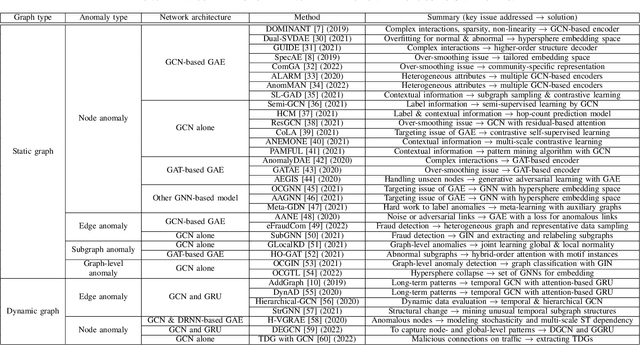Hwan Kim
ANOMIX: A Simple yet Effective Hard Negative Generation via Mixing for Graph Anomaly Detection
Oct 27, 2024



Abstract:Graph contrastive learning (GCL) generally requires a large number of samples. The one of the effective ways to reduce the number of samples is using hard negatives (e.g., Mixup). Designing mixing-based approach for GAD can be difficult due to imbalanced data or limited number of anomalies. We propose ANOMIX, a framework that consists of a novel graph mixing approach, ANOMIX-M, and multi-level contrasts for GAD. ANOMIX-M can effectively mix abnormality and normality from input graph to generate hard negatives, which are important for efficient GCL. ANOMIX is (a) A first mixing approach: firstly attempting graph mixing to generate hard negatives for GAD task and node- and subgraph-level contrasts to distinguish underlying anomalies. (b) Accurate: winning the highest AUC, up to 5.49% higher and 1.76% faster. (c) Effective: reducing the number of samples nearly 80% in GCL. Code is available at https://github.com/missinghwan/ANOMIX.
Deep Semi-supervised Anomaly Detection with Metapath-based Context Knowledge
Aug 21, 2023



Abstract:Graph anomaly detection has attracted considerable attention in recent years. This paper introduces a novel approach that leverages metapath-based semi-supervised learning, addressing the limitations of previous methods. We present a new framework, Metapath-based Semi-supervised Anomaly Detection (MSAD), incorporating GCN layers in both the encoder and decoder to efficiently propagate context information between abnormal and normal nodes. The design of metapath-based context information and a specifically crafted anomaly community enhance the process of learning differences in structures and attributes, both globally and locally. Through a comprehensive set of experiments conducted on seven real-world networks, this paper demonstrates the superiority of the MSAD method compared to state-of-the-art techniques. The promising results of this study pave the way for future investigations, focusing on the optimization and analysis of metapath patterns to further enhance the effectiveness of anomaly detection on attributed networks.
Graph Anomaly Detection with Graph Neural Networks: Current Status and Challenges
Oct 04, 2022


Abstract:Graphs are used widely to model complex systems, and detecting anomalies in a graph is an important task in the analysis of complex systems. Graph anomalies are patterns in a graph that do not conform to normal patterns expected of the attributes and/or structures of the graph. In recent years, graph neural networks (GNNs) have been studied extensively and have successfully performed difficult machine learning tasks in node classification, link prediction, and graph classification thanks to the highly expressive capability via message passing in effectively learning graph representations. To solve the graph anomaly detection problem, GNN-based methods leverage information about the graph attributes (or features) and/or structures to learn to score anomalies appropriately. In this survey, we review the recent advances made in detecting graph anomalies using GNN models. Specifically, we summarize GNN-based methods according to the graph type (i.e., static and dynamic), the anomaly type (i.e., node, edge, subgraph, and whole graph), and the network architecture (e.g., graph autoencoder, graph convolutional network). To the best of our knowledge, this survey is the first comprehensive review of graph anomaly detection methods based on GNNs.
 Add to Chrome
Add to Chrome Add to Firefox
Add to Firefox Add to Edge
Add to Edge